The best energy drinks for cycling help you meet your fuelling and, to a lesser extent, hydration needs in one.
These days, carb drinks taste pretty good too. Thanks to improved formulas, they are less likely to cause stomach trouble, provided you use them properly.
Despite their elite connotations, energy drinks aren't just for professional athletes. Sports nutrition experts recommend amateurs use them pretty much every day to ensure adequate carb intake.
With so many energy drinks on the market, it's hard to choose the right one(s) for you: all contain carbohydrates, but in differing quantities and ratios, while some contain electrolytes and others don't.
To help narrow down your choice, we've tested dozens of cycling energy drinks by guzzling bidon after bidon on all manner of rides.
We've picked our favourites based on factors including carbohydrate content and ratio, price per serving and taste.
For more advice on how to choose an energy drink for cycling, head to our buyer's guide at the bottom of the article.
Andy Blow, sports scientist and co-founder of Precision Fuel and Hydration, and Dr Tim Podlogar, nutritionist for Bora-Hansgrohe WorldTour team, have helped us answer some common questions surrounding energy drinks.
The best energy drinks for cycling, as rated by BikeRadar testers
SiS Beta Fuel 80
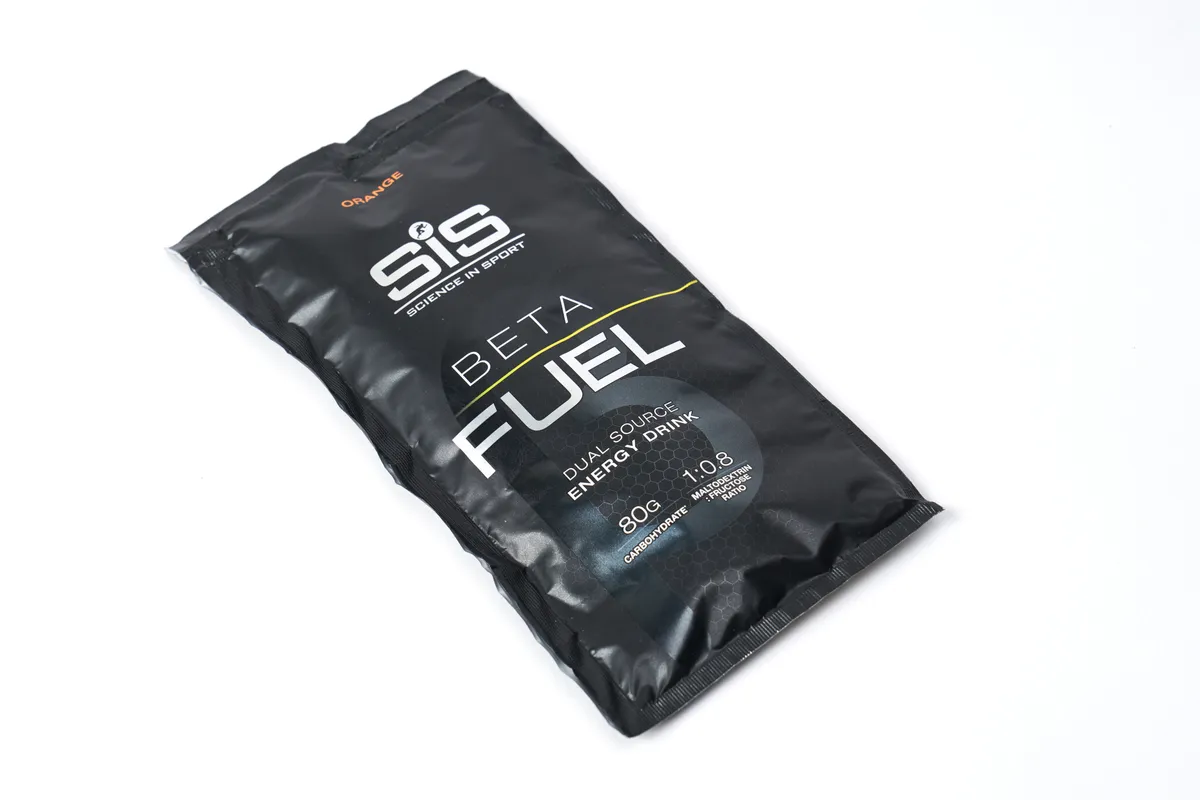
- Carbohydrates per serving: 80g
- Carbohydrate ratio: 1:0.8 maltodextrin to fructose
- Electrolytes: No
- Price per serving: £2.75/€3 per sachet
- Flavours: Orange, strawberry and lime
SiS Beta Fuel 80 is the cycling rocket fuel that powered Chris Froome’s 80km-solo stage victory in the 2018 Giro d’Italia, according to the brand.
But it’s not just for elite athletes – Beta Fuel’s 80g carbohydrates per serving can help you hit a very high hourly carb intake while riding all-out, or when riding slower in ultra-endurance events.
Citing scientific evidence, SiS says Beta Fuel’s 1:0.8 maltodextrin to fructose ratio helps you absorb the carbohydrates without experiencing GI upset.
Consuming up to two sachets of Beta Fuel 80 over the course of long gravel rides caused me no issues. In the orange flavour I tested, Beta Fuel was by far the best-tasting high-carb energy drink too.
The relatively high price per serving and gram of carbohydrate reflects that Beta Fuel 80 isn’t an everyday energy drink. Where performance really counts, in hard training sessions and events, it could be worth it.
The Beta Fuel 80 comes in sachets, which are easy to travel with and carry on the bike. But this could lead to more packaging waste than tubs or pouches.
Beta Fuel 80 is suitable for vegans and tested for banned substances, according to SiS.
Styrkr Mix90 Energy Drink Mix
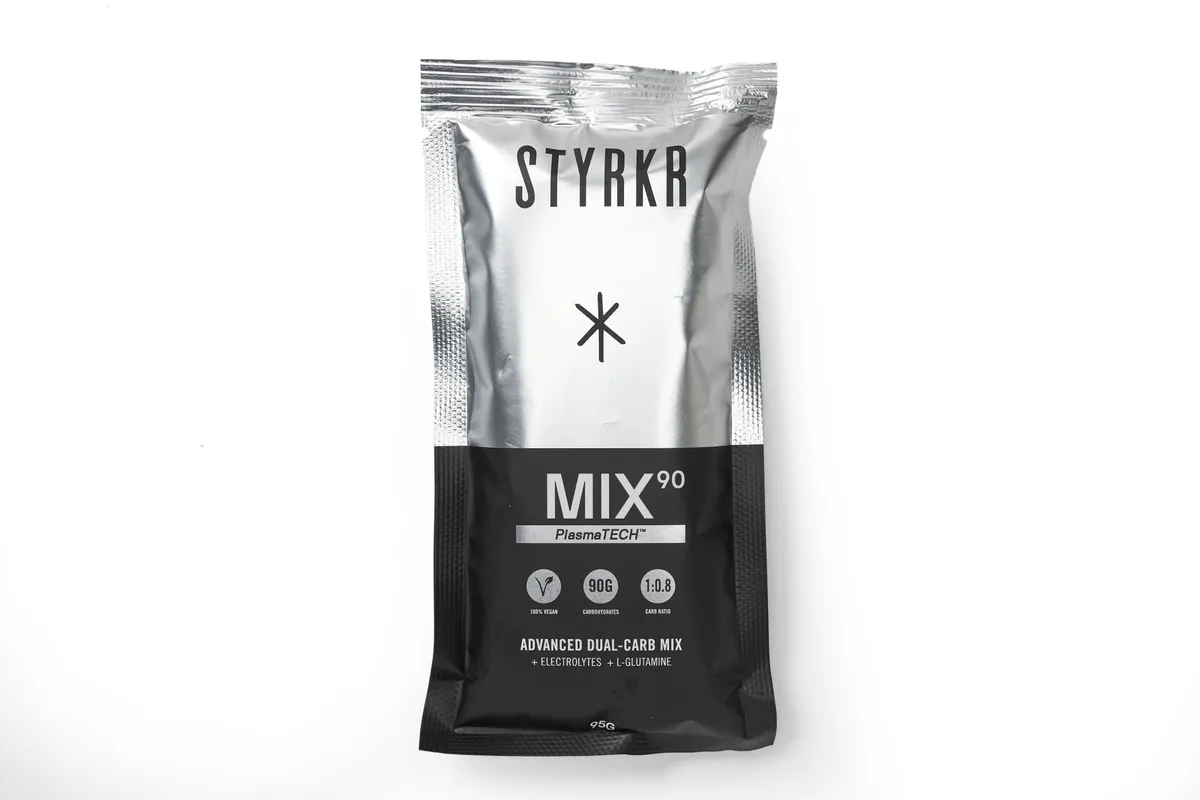
- Carbohydrates per serving: 90g
- Carbohydrate ratio: 1:0.8 maltodextrin to fructose
- Electrolytes: Yes
- Price per serving: £2.50
- Flavours: Neutral
The Styrkr Mix90 Energy Drink Mix is one of the punchiest around but tastes okay and sits well on the stomach.
Only top-level endurance athletes will benefit from and be able to absorb in an hour the 90g carbohydrates a serving contains.
But sipping the Mix90 Energy Drink Mix little and often worked well for me on audaxes. Two sachets spaced over several hours, together with energy bars and solid food, enabled me to ingest more than 60g of carbohydrates an hour.
Dissolved in 500ml of water, as Styrkr recommends, the Mix90 Energy Drink Mix is a little thick. It’s unflavoured but not that sweet for a high-carb mix.
This meant drinking a whole bottle over 1.5 hours while pushing along didn’t feel uncomfortable.
Styrkr says the Mix90 Energy Drink Mix contains electrolytes in the form of sodium chloride to replace salt lost in sweat. The brand claims added L-glutamine reduces blood ammonia build-up, a contributing factor to fatigue during exercise.
The price per serving compares well to high-carb rivals – Mix90 Energy Drink Mix delivers 10g more carbs than Beta Fuel for 25p less.
The Mix90 Energy Drink Mix is vegan, gluten-free and made from natural ingredients, according to Styrkr.
High5 Energy Drink
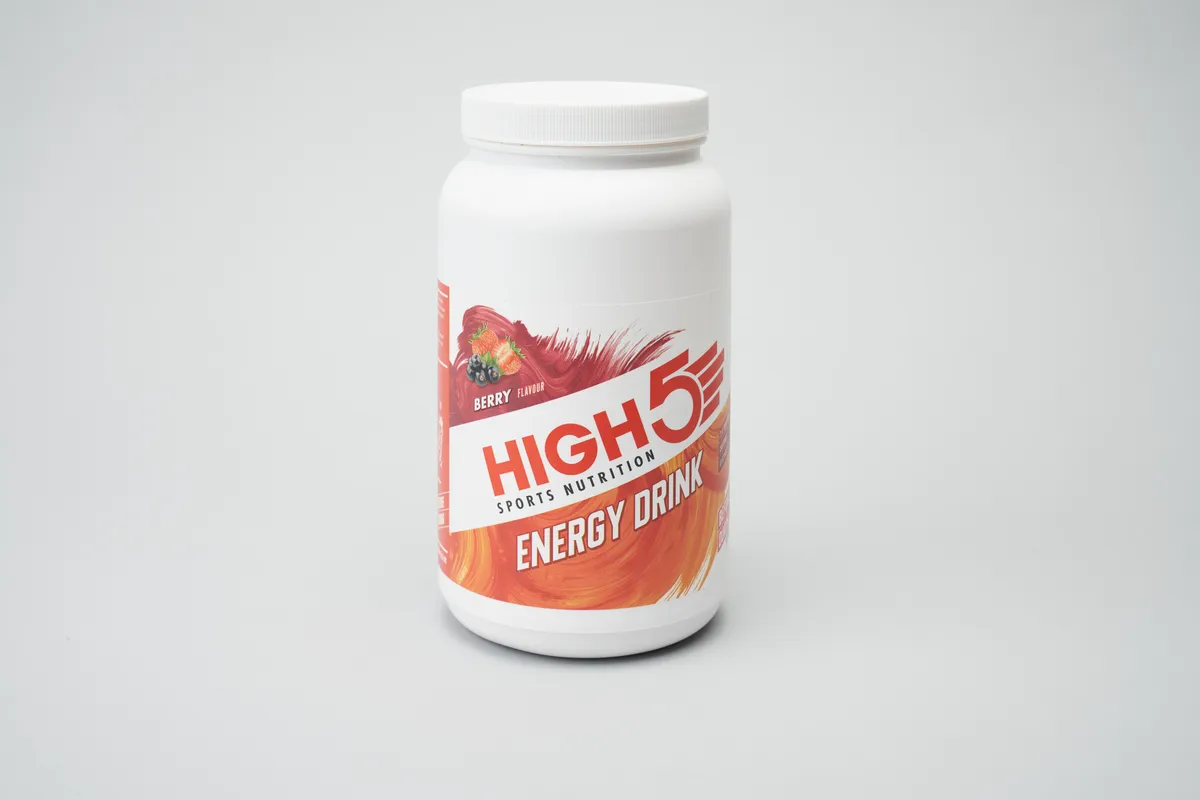
- Carbohydrates per serving: 44g
- Carbohydrate ratio: 2:1 maltodextrin to fructose
- Electrolytes: Yes
- Price per serving: £0.90 (1kg tub)
- Flavours: Berry, citrus, orange, tropical
The High5 Energy Drink provides a good amount of energy and some electrolytes at a reasonable price.
Despite the low cost, the High5 Energy Drink contains 44g of carbohydrates per serving in a 2:1 maltodextrin to fructose ratio. If desired, this can lift maximum carb absorption to 90g an hour without causing GI distress.
By ingesting additional carbs, I achieved this intake in testing. The light, refreshing and not overly sweet berry flavour (similar to Vimto) helped me drink multiple bottles on long rides.
The High5 Energy Drink has similar carb content to the SiS GO Energy Powder. However, the High5 Energy Drink contains electrolytes too ( sodium, potassium and chloride). It costs 7p less per serving in a 1kg tub versus 1.6kg.
High5 says the Energy Drink has been batch-tested for banned substances, earning Informed Sport certification.
The Energy Drink contains no artificial ingredients, but does contain citric acid, which can react with sugar to attack tooth enamel.
Maurten Drink Mix 320
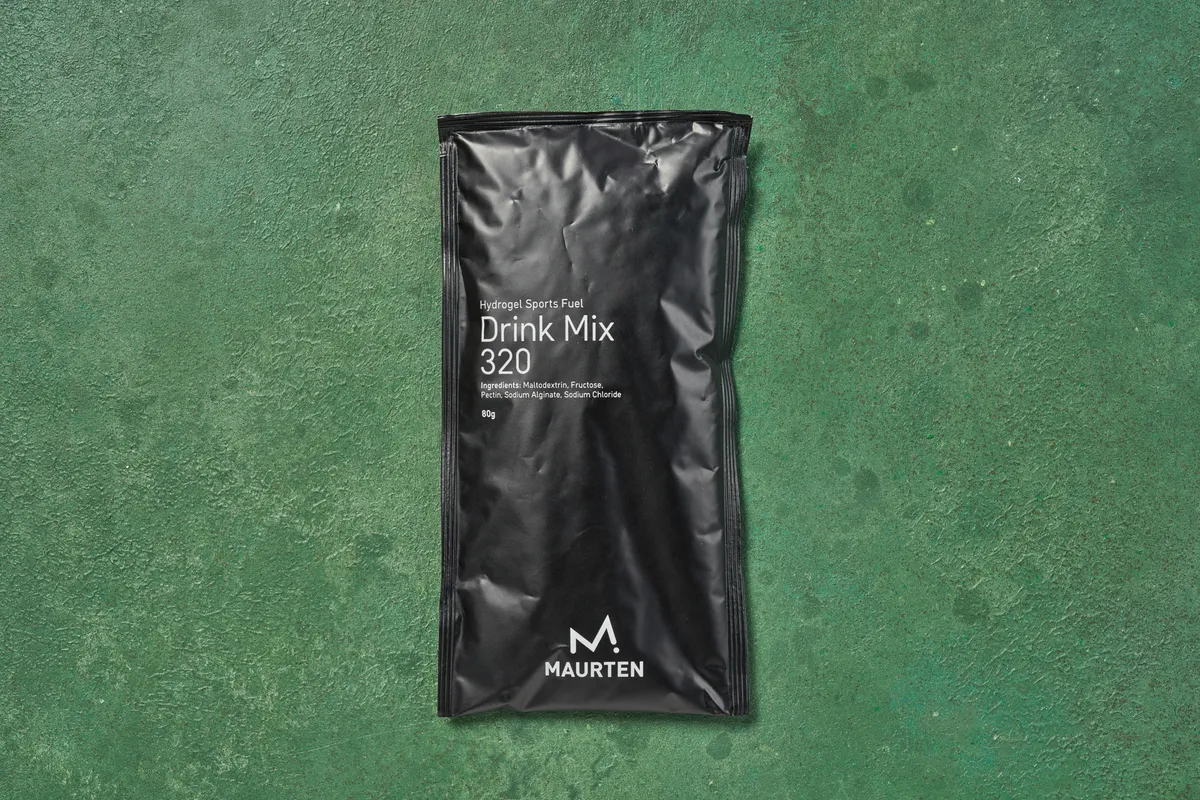
- Carbohydrates per serving: 79g
- Carbohydrate ratio: 1:0.8 maltodextrin to fructose
- Electrolytes: Yes
- Price per serving: £3.07
- Flavours: Neutral
The Maurten Drink Mix 320 has a colossal carb content and a price to match. It’s more expensive than products from SiS and Styrkr that deliver about 80g carbohydrates per serving.
Hydrogel technology renders the stronger version of the Drink Mix 160 even thicker, but not glutinous. The Drink Mix 320’s consistency takes some getting used to, but goes down fine.
The neutral taste and very high carbohydrate density lend themselves to all-out efforts when you need a lot of fuel but aren’t able to take on solid food.
Equally, sipping the Drink Mix 320 over longer rides helps easily achieve a high carbohydrate intake.
For example, if you drink a quarter or half a bottle of Drink Mix 320, you’ll only need one or two energy bars or gels to ingest 80g carbohydrates an hour.
Although the Drink Mix 320 is designed to meet high fuelling demands, it hydrates you too.
It contains sodium chloride to replace salt lost in sweat and stimulate thirst. This is beneficial in cooler conditions.
The Drink Mix 320 is vegan, vegetarian, free from artificial ingredients and certified by Informed Sport, according to Maurten.
Sachets make the Drink Mix 320 portable but perhaps less good for the environment than energy drinks that come in tubs.
OTE Supercarbs

- Carbohydrates per serving: 80g per 500ml
- Carbohydrate ratio: 1:0.8 maltodextrin to fructose
- Electrolytes: Yes
- Price per serving: £3.25/€3.90 (850g bag)
- Flavours: Blackcurrant, lemon & lime
OTE Super Carbs is the British brand’s high-carbohydrate delivery energy drink mix.
It packs in 80g of carbs per 500ml serving, alongside a series of electrolytes designed to replace those lost through sweat.
I enjoyed the taste of the blackcurrant sample product I had on test, but it took a few rides to get used to the level of energy delivery. Initially, I felt a little buzzy, but this sensation soon passed as I grew accustomed to the drink.
However, the same might be said for all energy drinks that pack such high energy levels into a concentrated formula.
At the very least, it’s worth working out if your cycling is as intense as it needs to be to burn through it sufficiently, or else adjust how much you’re consuming (balanced with the need to take on fluid to stay hydrated).
As a result, some might be better off with OTE’s standard energy drink, or another of the same ilk. But for high-intensity riders, such as road racers, the application is clear.
Super Carbs is one of the best high-carb mixes. However, it’s more expensive per serving than either SiS Beta Fuel 80 (which comes in usually costlier, but more convenient sachets), or Styrkr Mix90 Energy Drink Mix (which packs in 90g of carbs per serving).
Handily for those who need it, OTE Super Carbs comes with Informed Sport batch-testing accreditation.
SiS Go Energy Powder
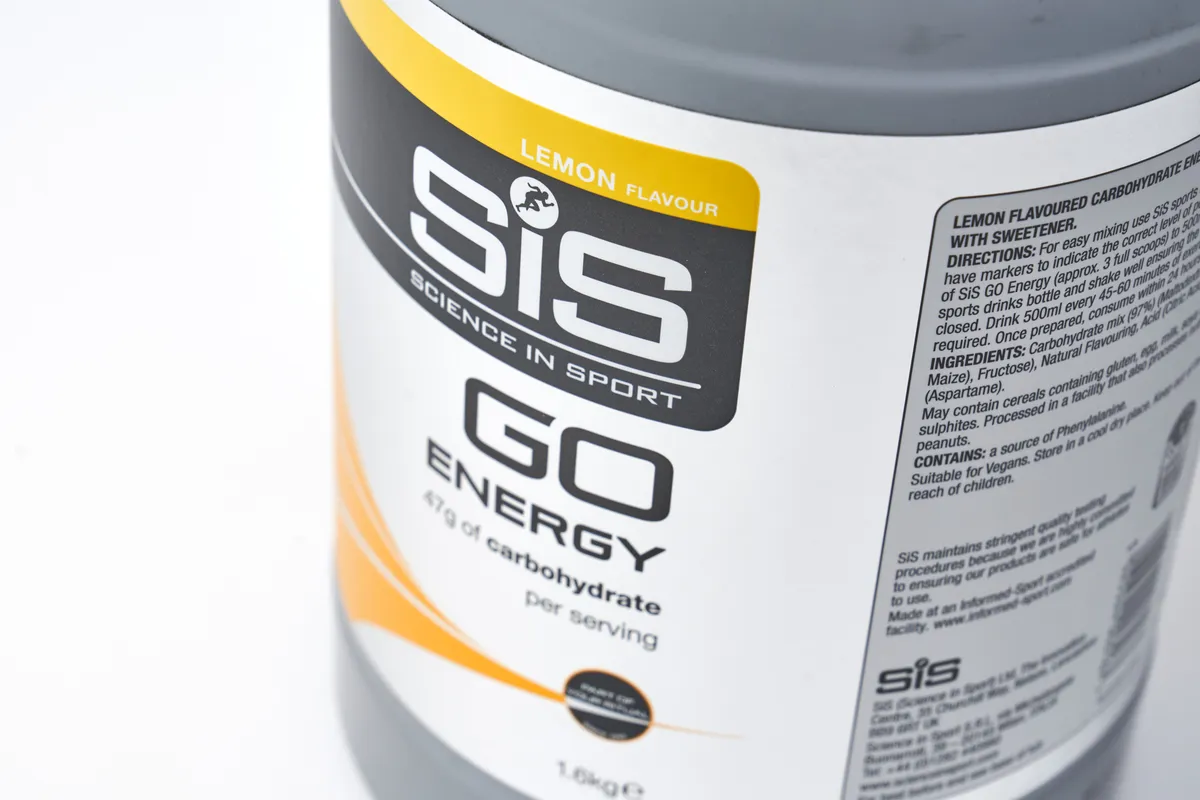
- Carbohydrates per serving: 47g per 500ml
- Carbohydrate ratio: 2:1 maltodextrin to fructose
- Electrolytes: No
- Price per serving: £0.97/€1.09 (1.6kg tub)
- Flavours: Blackcurrant, lemon, orange
SiS Go Energy Powder is an excellent all-round energy drink that will meet moderate energy needs on medium to long rides.
Each 500ml serving contains 47g carbohydrates per serving in a 2:1 maltodextrin to fructose ratio.
For endurance rides, this sits in the middle of the recommended carbohydrate intake of 30g to 60g per hour.
So, you could drink less than a bottle an hour to stay at the lower end or top up with other energy sources to go up to or above 60g.
The lemon flavour was one of the tastiest energy drinks I tested. I didn’t get tired of drinking it or experience stomach problems on multiple-hour rides. However, the addition of the sweetener aspartame seems unnecessary.
Price per serving and per gram of carbohydrate (2p/g) is competitive in the 1.6kg tub size.
SiS says the Go Energy Powder is vegan and Informed Sport certified (tested for banned substances).
Torq Energy
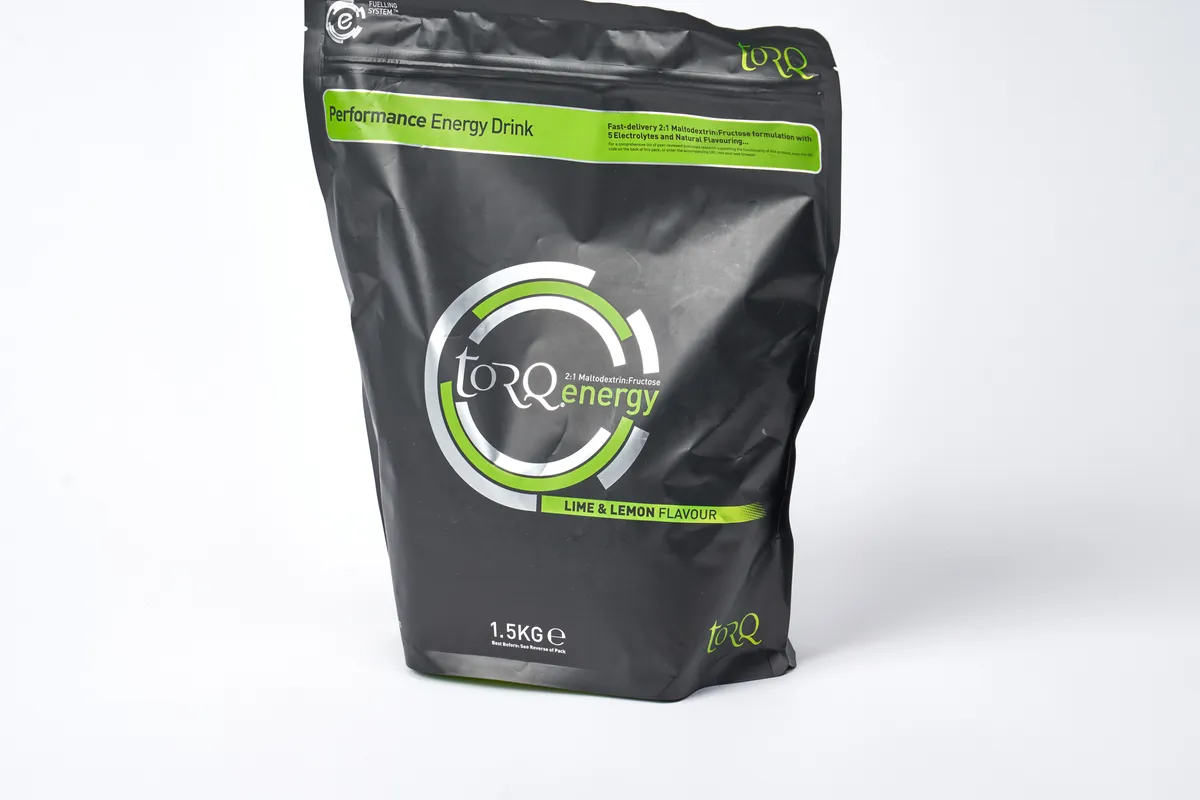
- Carbohydrates per serving: 30g per 500ml
- Carbohydrate ratio: 2:1 maltodextrin to fructose
- Electrolytes: Yes
- Price per serving: £0.84/€0.78 (1.5kg bag)
- Flavours: Orange, lemon & lime, pink grapefruit, lemon, blackcurrant, vanilla pod and cola caffeine
Per 500ml serving, Torq Energy is among the best-value, easy-to-drink energy drinks available today.
Although SiS Go Energy and High5 Energy Drink deliver more carbohydrates per bidon, and work out to be a little cheaper on a carb-per-currency basis, the difference isn’t so much that you should ignore Torq.
Torq intends you to use the drink as part of its own energy ‘Torq’ unit system. One 30g/500ml bottle equates to one unit, which you can top up with a gel, bar or chew to make three (90g carbs).
Despite the somewhat foreboding packaging – the black-heavy branding doesn’t scream ‘natural’ – there are no artificial sweeteners.
Handily, the package includes a QR code, making it easy to read over the peer-reviewed studies Torq says corroborate the efficacy of the product.
It has a tasty flavour (I tested lemon & lime here, but have also sampled orange and pink grapefruit), yet is light enough to not feel the need to swig water in addition.
There’s also a cola flavour with caffeine, should you want an extra kick.
Enervit Isocarb C2:1 Pro
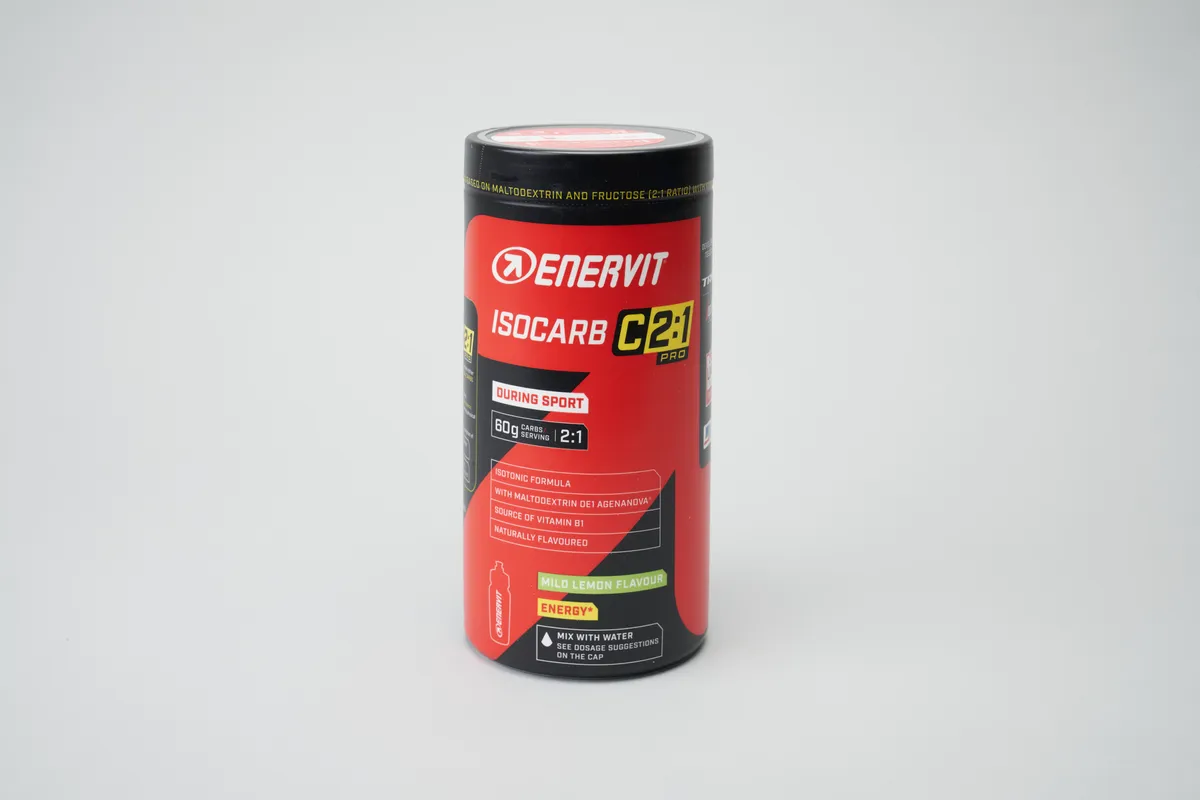
- Carbohydrates per serving: 60g per 500ml
- Carbohydrate ratio: 2:1 maltodextrin to fructose
- Electrolytes: Yes
- Price per serving: £1.80/€1.79 (2x650g tub)
- Flavours: Lemon
Enervit Isocarb C2:1 Pro is a versatile energy drink that you can mix to three different strengths.
Used by WorldTour teams Lidl-Trek and UAE Team Emirates, the Isocarb C2:1 Pro can have a pro-level carb content.
One scoop of powder in 500ml of water makes a hypotonic drink (best for hydration) with 30g carbohydrates. Two scoops in 500ml doubles the carbs in an isotonic solution.
In a 2:1 maltodextrin and fructose ratio, 90g carbohydrates is generally considered the upper limit of what a well-trained athlete can absorb in an hour.
But Enervit says its unique 2:1 ratio, using maltodextrin DE1 Agenanova, enables you to ingest 90g per hour (from three scoops of powder in 750ml water).
I drank this strongest serving in just over an hour without any adverse effects.
The lower fructose content, natural lemon flavouring and citric acid take the edge off the sweetness as you increase the strength. However, citric acid and sugar can be a bad combination for dental hygiene.
Considering the Isocarb C2:1 Pro energy drink’s versatility and high carb content, it presents decent value at £1.80 per serving.
Isocarb C2:1 Pro contains no artificial colours, flavours or sweeteners, but may have traces of milk, soybeans and eggs, according to Enervit.
OTE Energy Mix
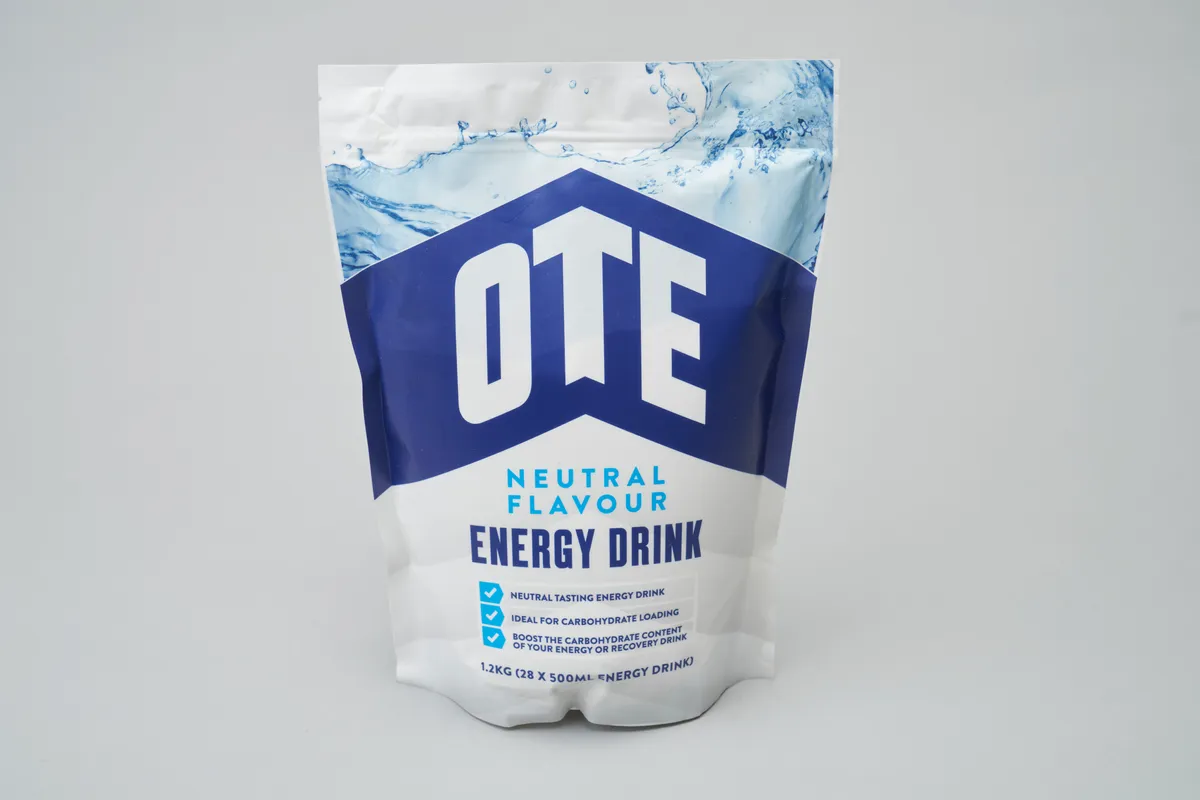
- Carbohydrates per serving: 40g per 500ml
- Carbohydrate ratio: 2:1 maltodextrin to fructose
- Electrolytes: Yes
- Price per serving: £1.14/€1.46 (1.2kg bag)
- Flavours: Neutral, orange, lemon & lime, blackcurrant
OTE Energy Mix is a good-performing energy drink for moderate exercise that’s easy on the stomach.
It uses a 2:1 blend of maltodextrin and fructose – 40g per 500ml serving – to provide the necessary carbohydrates to see you through exercise.
This is slightly less than the 47g supplied in the same ratio by SiS Go Energy Powder, but still within the 30-60g general recommendation for carbohydrate intake.
Compared to that product, it’s also a touch more expensive per serving (£1.14/€1.46 versus £0.97/€1.09), and doesn’t have specific Informed Sport certification (albeit OTE says it’s produced in a factory that does).
Where OTE differs is that it offers a genuinely neutral-tasting option, on top of the orange, lemon & lime and blackcurrant flavours.
I tested the neutral product here, but have tried the three flavoured options in recent times and all are lightly sweet without ever becoming cloying on the palette.
I’ve found I can stick with a flavoured OTE Energy Mix drink for a day-long ride and not get bored, assuming I have some contrasting solid food along the way. The electrolyte balance is said to help with hydration too.
Precision Fuel and Hydration Carb and Electrolyte Drink Mix

- Carbohydrates per serving: 30g per 500ml
- Carbohydrate ratio: 2:1 glucose to fructose
- Electrolytes: Yes
- Price per serving: £1.33/$1.66/€1.53/AU$2.47 (510g bag)
- Flavours: Neutral
The Precision Fuel and Hydration Carb and Electrolyte Drink Mix is meant to replenish energy and sweat losses in exercise.
Scientific opinion is divided on the merits of electrolytes. But Precision Fuel and Hydration claims the salts contained in its hypotonic energy drink help prevent cramp when you’re sweating a lot.
Therefore, it says the Carb and Electrolyte Drink Mix is best for hard riding in hot weather when you want to ingest a moderate amount of carbohydrates from fluid.
Formerly called PF 60 Drink Mix, the Carb and Electrolyte Drink Mix tastes like slightly salty orange squash.
This comes from added citric acid, natural flavourings and mineral salts, including 500mg sodium per 500ml. I found the mix perfectly palatable and digestible.
Over longer durations, I supplemented the 30g carbohydrates (2:1 maltodextrin to fructose ratio) per 500ml of the Carb and Electrolyte Drink Mix with bars and gels.
The brand has released a Carb Only Drink Mix, which enables you to achieve a higher carb intake (up to 60g per 500ml bottles) from the drink alone.
Precision Fuel and Hydration Carb and Electrolyte Drink Mix is Informed Sport certified, so it shouldn’t contain banned substances. It’s also vegan and free from artificial ingredients, according to the brand.
Buyer's guide to cycling energy drinks
What is a carbohydrate energy drink?

Precision Fuel and Hydration’s Andy Blow says: “An energy drink’s primary purpose is to provide energy from carbs.”
The carbohydrates in an energy drink powder will come from simple sugars, such as maltodextrin, glucose and fructose.
Cycling energy drinks will sometimes contain flavourings, caffeine and electrolytes, which we’ll get on to later.
Because the drink mix dissolves into water, the solution will hydrate you.
But Blow adds: “You’re primarily drinking it to get enough energy into your system rather than enough fluid.”
Carb drinks will typically start at five or six per cent carbohydrate, providing 50g to 60g carbohydrates per litre.
Isotonic vs hypertonic energy drinks
There are two main types of cycling energy drinks as defined by their osmolarity or concentration relative to the blood.
Precision Hydration’s Andy Blow says isotonic drinks have a similar concentration to the blood of about 290mOsm/l.
This means their medium-carb content passes into the blood quite quickly.
On the other hand, hypertonic drinks contain more carbohydrates and are more concentrated than blood from 300mOsm/l to 500mOsm/l.
Hypertonic drinks provide lots of energy but they take longer to absorb, according to Blow.
In hot weather, they can contribute to nausea, thirst and even dehydration. Once the hypertonic drink is inside your gut, your body removes water from your blood to maintain the correct concentration of liquid in your intestine.
Therefore, hypertonic drinks are better at meeting high-energy demands than hydrating you.
This isotonic formula has a similar concentration to your blood, which aids absorption.
Stronger carbohydrate drinks, which contain more than 80g carbohydrates per serving, are hypertonic.
Blow says: “This makes them good for delivering energy and less good for hydration.
Their carbohydrate content slows their passage through your gut and, in turn, their rate of absorption.
Why should I use carbohydrate energy drinks?
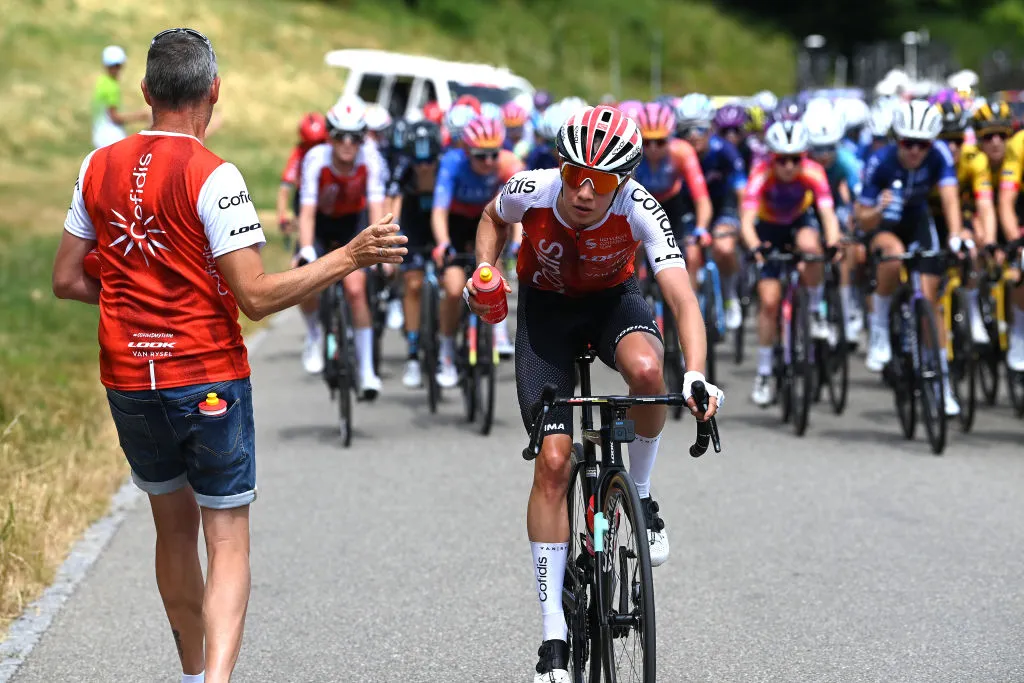
Blow says: “Carbohydrate energy drinks are fantastic for short- and medium-length races, especially when the weather’s not super-hot.
“You can get pretty much everything you need in one bottle: carbs, some fluids and maybe a little bit of electrolytes.
“You can drink them even when breathing hard and they’re convenient because you don’t have to carry and open gels.”
Even when not racing, Dr Podlogar, who has a PhD in exercise metabolism from the University of Birmingham, recommends carrying a carb drink on almost every ride to avoid bonking.
“You always need a supply of energy unless you're going for a short coffee ride and it’s less than one hour.
“If it's longer than one hour, you probably want some carbohydrates, and the easiest thing is to get carbohydrates and fluids at the same time,” he explains.
How should I use carbohydrate energy drinks for cycling?
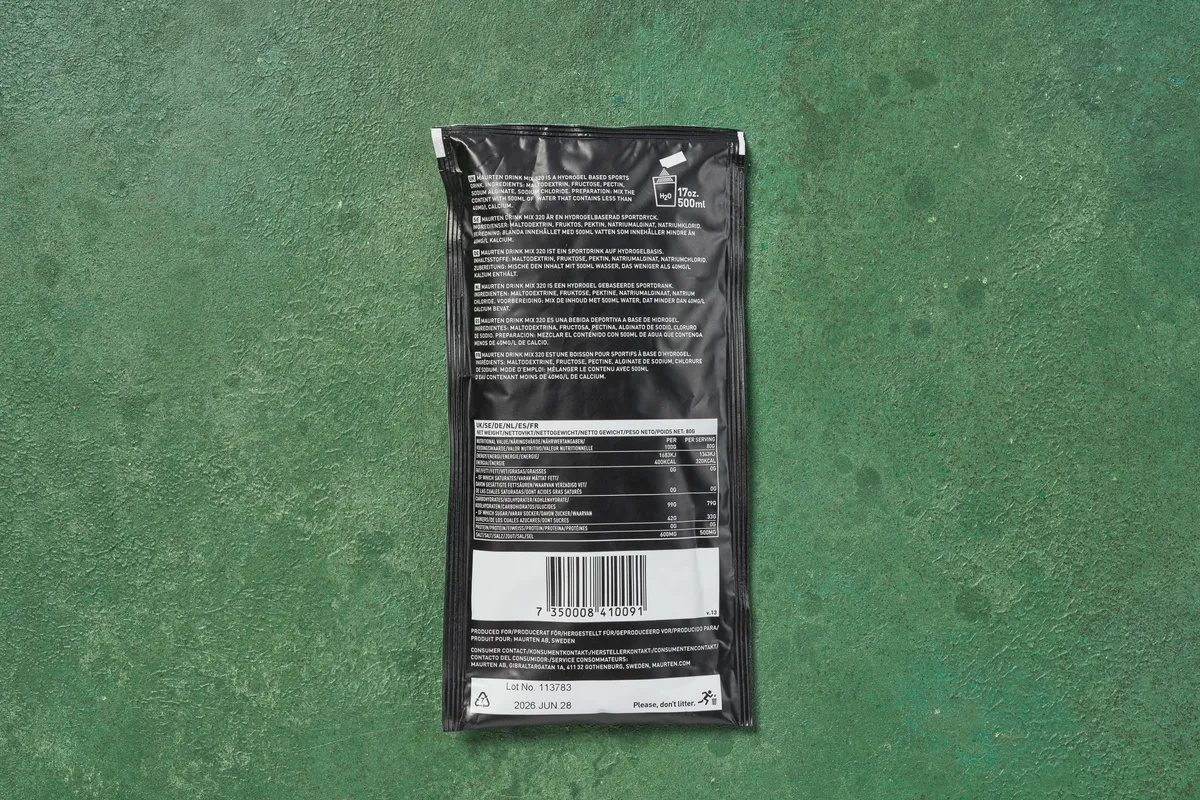
Both Blow and Dr Podlogar say energy drinks, particularly those high in carbs, should be used in moderation in the heat.
Blow says: “You’ve got to be careful about how you use them in longer and really hot races.
“Hydration is more of a priority. You might get a contribution of your energy from carb drinks, but you can’t rely on them alone.
“The volume of them would be so high it would probably give you a bad stomach.”
Hypertonic sports drinks’ slower transit through the gut membrane can trigger gastrointestinal issues, according to Dr Podlogar.
What’s more, he says the inevitably syrupy nature of high-carb drinks is not that refreshing.
So he agrees that as you sweat and drink more, a less concentrated carb drink is better.
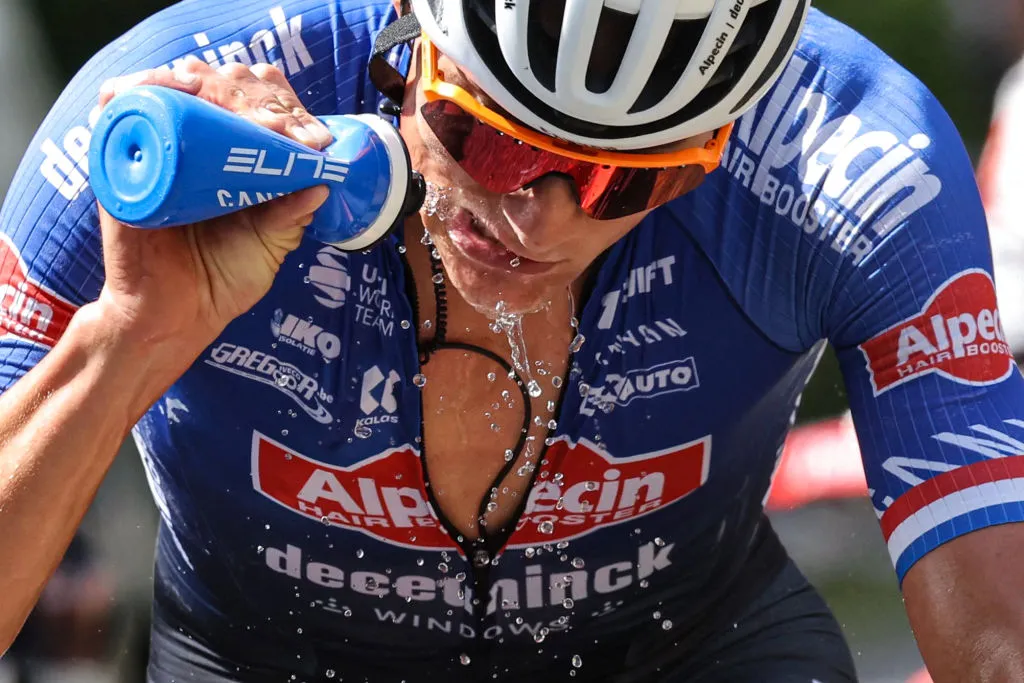
On long, hot Tour de France stages, riders will have some carb drink along with energy gels, water and possibly electrolyte drink.
During longer rides, Blow says it is a “safer, overall strategy” for amateurs to take most of their carbs from food and a little from an energy drink.
Dr Podlogar agrees, explaining: “This way you can separate hydration from nutrition so you know exactly what you’re having.”
In general, there’s no need to drink a set amount of fluid, according to the nutritionist.
“For 99 per cent of people, it’s fine to drink to thirst,” he says.
At Bora-Hansgrohe, the team doesn’t try to match fluid intake with sweat rates, as some sports scientists previously advocated.
What to look for in a cycling energy drink
The carbohydrate content and where it comes from, the taste and the presence or absence of electrolytes are the key things to consider when choosing an energy drink for cycling.
Carbs per serving

To work out how many carbs you need per serving of energy drink, you need to look at how many carbs you want to take in per hour and factor in how much fluid you'll drink.
For example, Blow says you could hit 90g carbohydrates an hour with one 30g-carbohydrate bottle and two bars or gels; or in hotter weather, with two 30g bottles and one bar or gel.
Dr Podlogar underlines the importance of personal preference too.
Some riders prefer to drink all their carbs in fluid, so need a stronger solution; others opt to top up their intake with energy bars and gels, so need a weaker carb drink.
However, because you’ll need to drink less on cooler rides, he argues high-carb drinks can be better in winter.
For example, to ingest 90g carbohydrates in summer, you could drink two bottles each containing 45g carbs.
In the winter you’d rarely drink two bottles an hour. So you could aim to drink one bottle an hour of a more carb-concentrated drink, such as Beta Fuel.
Sugar sources
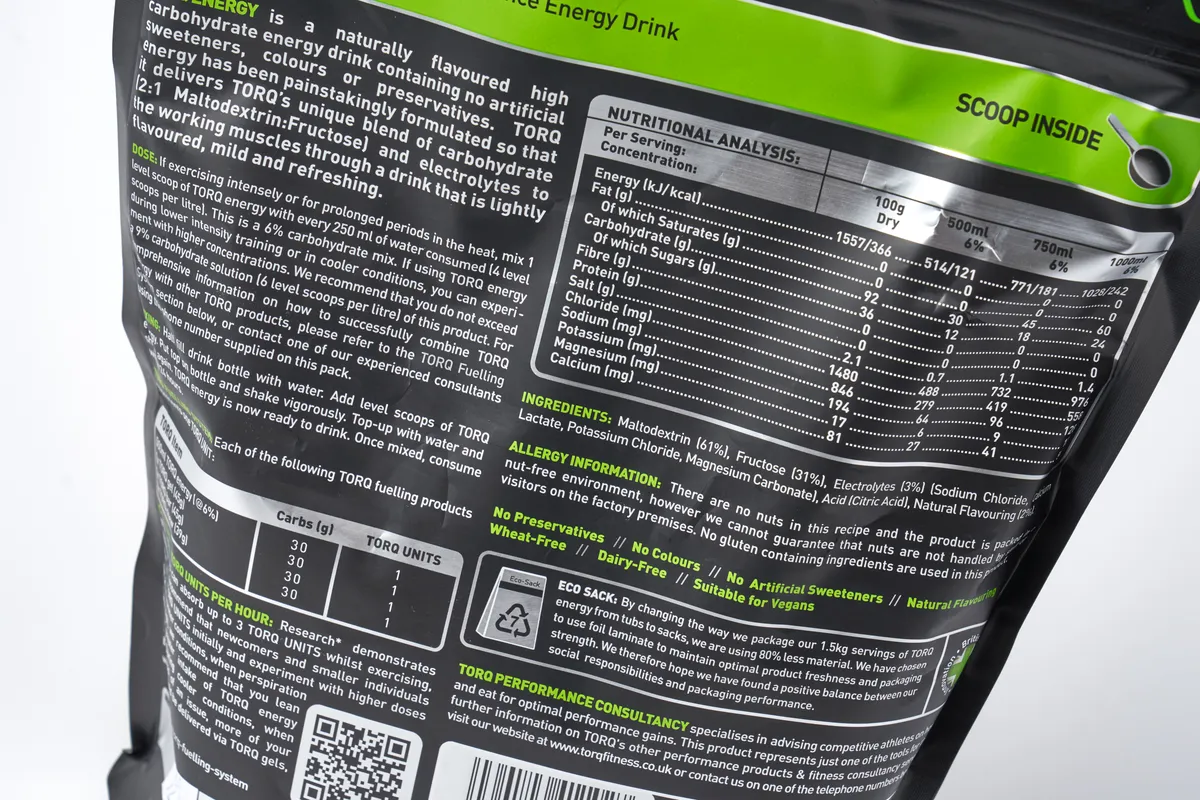
The best energy drinks will contain multiple types of sugar.
“With only one type of carbohydrate, such as glucose, or dextrose or maltodextrin, you can only absorb 60g carbohydrates per hour, whereas as soon as you add fructose, you can go higher,” explains Dr Podlogar.
Blow says maltodextrin is commonly used in sports drinks because it’s not too sweet but is carb-dense.
It breaks down into glucose, hence the need for another type of sugar, such as fructose.
Taste
Cycling energy drinks come in a range of flavours, with many of the stronger variants being unflavoured. Trial and error will determine which one appeals most.
Blow prefers a minimalist taste because “strong, sweet or syrupy flavour will get quite annoying after a while”.
That said, Dr Podlogar says the best energy drinks don’t have to taste magnificent – you won’t have to drink three bottles a day for 20 days like the pros on a Grand Tour.
Electrolytes
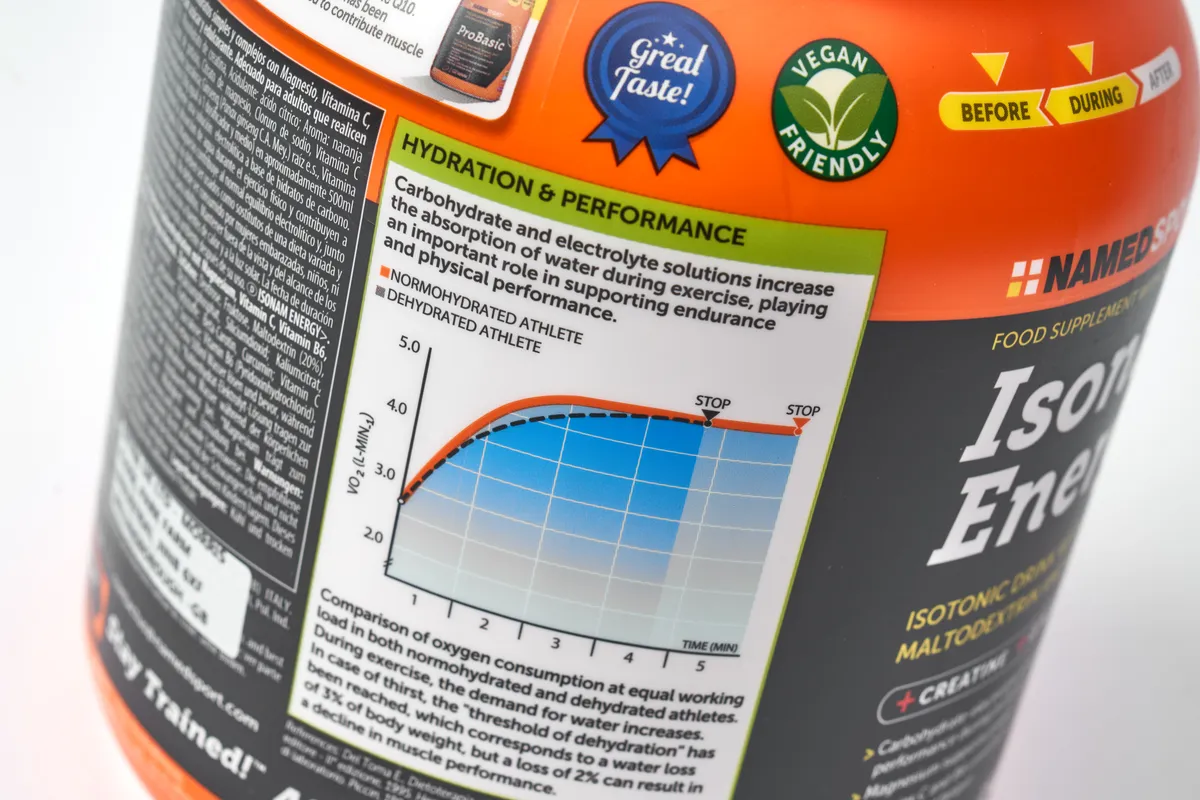
Contrary to general consensus, Dr Podlogar recommends drinking electrolytes in any weather.
“In the winter, electrolytes are equally as important [as in summer].
“Although sweat rates are low or non-existent, riders can experience the need to pee quite a lot in the first hour of a ride,” says Dr Podlogar.
“This is because blood vessels constrict under the skin, so the body gets rid of water [through urine].
“Electrolytes help you retain the fluid and so you have to pee less often.”
Additives
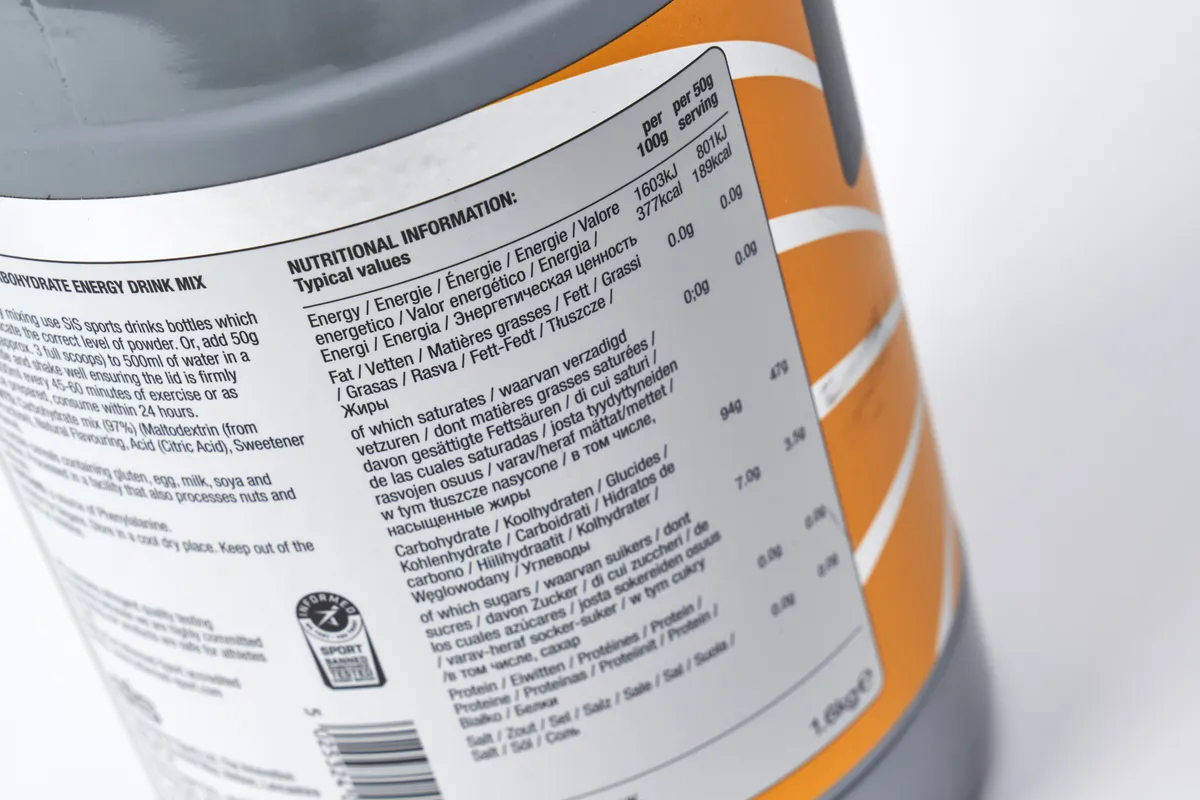
Dr Podlogar steers clear of cycling energy drinks containing citric acid. Some brands add this to reduce the drink’s sweetness.
He says the reaction between sugar and citric acid on your teeth can cause decay.
Regardless of citric acid content, he advises chasing down more sugary drinks with plain water to wash some of the sugar off your teeth.
Which carbohydrate ratio should you choose?

In the past, the typical carbohydrate ratio in sports nutrition products, including energy drinks, was 2:1 maltodextrin to fructose.
But there is growing scientific evidence that a higher proportion of fructose to maltodextrin is preferable.
Studies have found that a 1:0.8 maltodextrin to fructose ratio enables athletes to absorb more carbohydrates during exercise (over 120g an hour in elites) without encountering GI distress.
As a result, many high-carb energy drinks now use this 1:0.8 ratio. Cheaper, low-carb options still contain twice as much maltodextrin as fructose.
Blow is sceptical about the benefit of a 1:0.8 carb ratio for most athletes, while Dr Podlogar favours this ratio all the time.
Although Blow concedes having more fructose relative to maltodextrin could aid carbohydrate absorption, he says: “That is a very marginal gain, if it’s a gain at all.
“What’s more important is hitting the real high numbers.”
Dr Podlogar favours the 1:0.8 ratio all the time based on evidence from his own studies.
“It was pretty clear that the 1:0.8 ratio was better for both absorption and GI comfort,” he says.
But having more fructose in proportion to maltodextrin makes the drink sweeter, possibly overly so for some palates.
Dr Podlogar admits there is no way around this potential downside besides adding citric acid, which he opposes.
What’s the difference between energy and electrolyte drinks?

As alluded to above, the primary function of an energy drink is to provide carbohydrates to fuel your cycling.
Electrolyte or hydration drinks are designed to hydrate you by replacing fluids and electrolytes (charged ions you lose in your sweat, such as sodium).
Blow says electrolyte drinks will have a high concentration of electrolytes, typically from 500mg to 1,000mg of sodium per litre.
They will contain next to no carbohydrates to make them pass into your gut quicker than carb drinks, speeding up rehydration.
Sports scientists disagree about whether you need to replace electrolytes during exercise to prevent cramping, for example.
But Blow says many elite cyclists use electrolyte drinks, especially during long, hot races.
